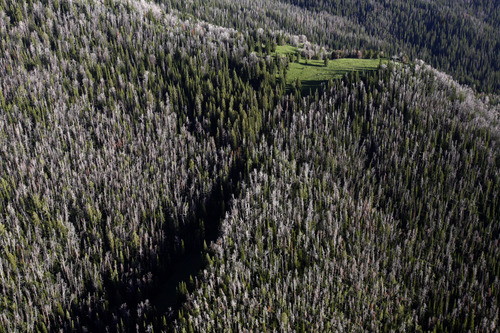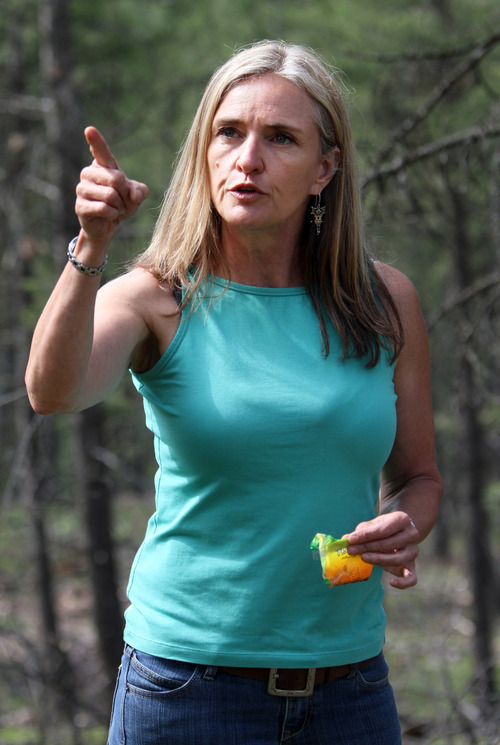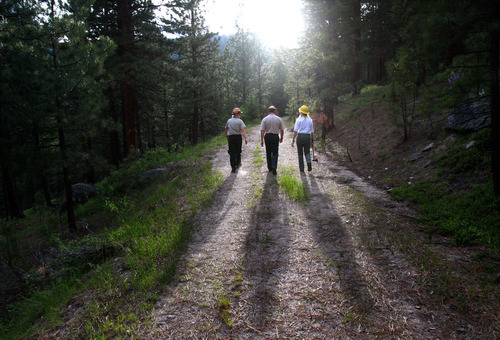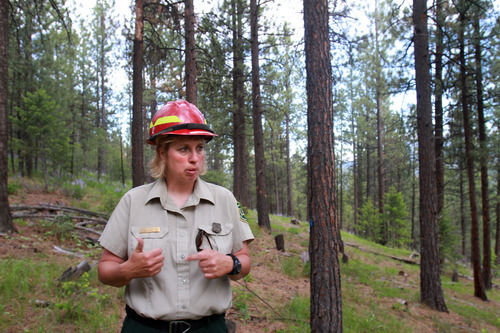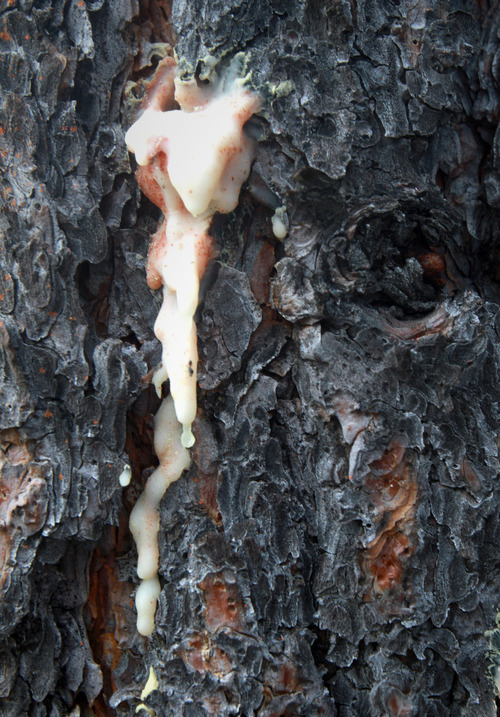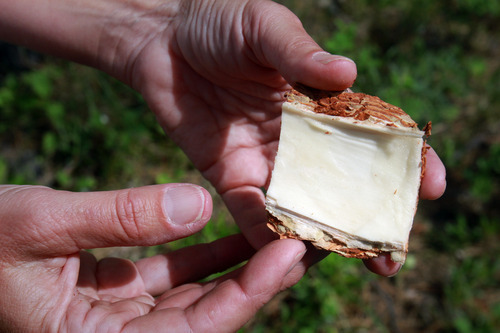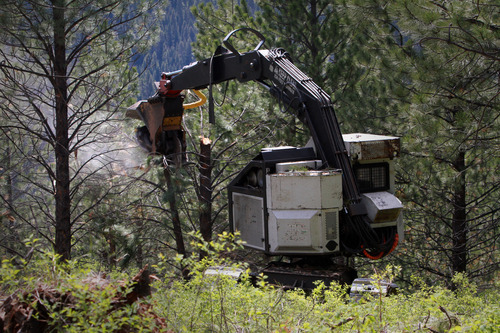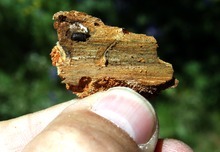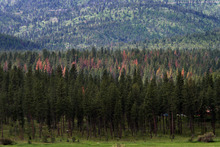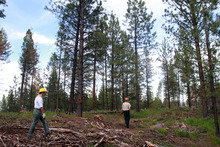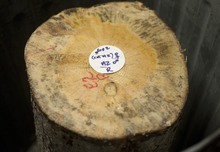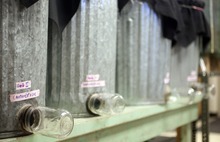This is an archived article that was published on sltrib.com in 2011, and information in the article may be outdated. It is provided only for personal research purposes and may not be reprinted.
To see a map of the affected areas, visit http://bit.ly/forestmap
Bozeman Pass, Mont. •A gray-whiskered former fly-fishing guide waded through a horse pasture whacking weeds for his neighbor, the rumbling machine in his hands slicing thistles and sparing a robust tangle of grass and wildflowers, while on mountain ridges all around him, the trees silently died.
Beetles.
Here, along the pine-scented exurban glory of Trail Creek, Lester DuChane and his sparse neighbors are the latest Westerners to watch their green valley turn red and fade to gray as swarms of rice-grain-size beetles eat the Rocky Mountain forest. He cannot figure out why the government never launched an aggressive counterattack against an epidemic, which has swept through neighboring ranges almost since he settled here in 1994.
"They say they're working on it," DuChane sneered, remembering his pleas with Gallatin National Forest rangers. "It's the government. It ain't doing anything."
His is a complaint echoed by Western politicians, who think government land managers heaped disaster on the region by letting forests grow so thick that the trees cannot get enough water and sunlight to defend themselves from the pests.
But what if something larger than the federal bureaucracy is at work? What if the real culprit isn't a faltering Uncle Sam but a changing Mother Nature?
A rogue wave of insects riding on a decade of drought and ever-warmer winters is now cresting here, where DuChane believes his perch is threatened: the elk he hunts, the view and the trout that brought him west from Wisconsin, and, in case of fire, even the home he built for himself.
"You won't see this in my lifetime," DuChane said, tilting his cowboy hat at the few patches of green that remain but will fade by next summer. The replacement trees, if they grow, will take a century to mature.
"It's gone."
America's alpine climate has changed dramatically in recent decades, warming enough for university and government researchers to state flatly that nothing will ever be the same.
Not the widely spaced natural cycle of beetle kills. Not the small fires that routinely thinned and rejuvenated forests. Not the trees themselves, which may shift to new species better adapted to a changing habitat. Across the continent's spine, the forests that defined the Marlboro Man's high West are dead, dying or so choked with combustible life that they inspire more fear than wonder.
High-elevation trees that shade and anchor snowbanks through spring are most susceptible, perhaps leading to earlier runoff, greater flooding and dirtier rivers. A millennium-spanning species whose pine nuts fatten Yellowstone grizzlies is startlingly on the brink, bug-struck and sun-bleached into alpine skeletons of incomprehensible body counts. Mountain pine beetles are flying in new territories previously thought too cold, such as northern British Columbia or just under the thin-air crags of western Wyoming's Tetons. Utah's dominant tree of commercial value, the Engelmann spruce, is under attack and, by Forest Service estimates, may survive only in the High Uintas by century's end.
—
Millions of lost acres • Five years ago, Jesse Logan retired to Paradise Valley, a 20-minute drive north of Yellowstone, after leading the Forest Service's bark-beetle studies. He wanted to fish and ski, but he also keeps busy documenting the loss of old trees on nearby mountaintops — the ones he likes to ski between and the ones that regulate water flows and temperatures by holding snow into summer. Without them, the native cutthroat trout he stalks will suffer.
"These forests are enchanting places," Logan said. "[Yellowstone] just captured my imagination and my heart, and it breaks my heart to see what's happening in these high-elevation, old-growth forests."
Part of foresters' diagnosis reflects a cold reckoning of facts known for a generation: A century of Smokey Bear fire suppression and decades of timber-industry decline primed thick forests for giant blazes and for drought stress, which invites tree-killing insects. The other part is new: Warming winters and longer growing seasons have ignited a 14-year beetle explosion like none ever documented.
Brighton Ski Resort southeast of Salt Lake City, topping out at 10,500 feet, has warmed its average nightly winter lows by more than 5 degrees Fahrenheit over four decades, according to the Utah Climate Center at Utah State University. It doesn't feel so different through puffy gloves when you're skiing under the lights, but it represents fewer bug-killing deep freezes.
Mountain pine beetles have sapped acres of the gnarly old limber pine that defined the ridge, "a sad thing because some of those are hundreds of years old," ski area Manager Randy Doyle said. Employees have tacked synthetic anti-beetle pheromones on the remaining 200 or so limber pines.
Spruce beetles spilling over the crest from American Fork Canyon form a second front at Brighton, forcing the resort to selectively cut pockmarked spruce — a couple of hundred last year — in hopes of removing the insects before the next generation emerges. Unlike pine beetles, spruce beetles so far have evaded efforts to produce a synthetic pheromone repellent. Brighton plants and shelters seedlings for the next generation, hoping for a hospitable landscape.
Since 1997, a host of native beetle species has chewed through more than 40 million acres of Western forests, according to aerial surveys by the U.S. Forest Service. That's as much space as all of America devotes to its lawns. And the beetles show no signs of crashing.
They kill by burrowing into the fleshy layer of nutrient-conducting phloem — just under the bark — which their larvae eat and effectively girdle.
Various bugs have swallowed 2 million acres of Utah forests, a patchwork about as large as Yellowstone National Park.
In Montana, with more than 6 million acres of beetle carnage, second only to Colorado, the frost-free season has extended by two weeks in the past half-century. That's pleasantly milder for people who once routinely bundled themselves against 40-below zero winters, but it's torturous for pine trees.
"In the arid West, you only have a growing season if it has enough water, just like your garden," said Steve Running, ecology professor and University of Montana Climate Change Studies Program director.
But the region hasn't gained water, and most climate models predict it will lose moisture to evaporation even when more falls as snow or rain.
"It means a longer stress period for the trees," said Running, whose research on global forests helped the U.N. Intergovernmental Panel on Climate Change share the 2007 Nobel Peace Prize with former Vice President Al Gore. "Stress on the tree host is to the advantage of the invading insect."
So trees around the Rockies will have to grow with more spacing, Running said, as a response to changes in precipitation and evaporation. That could mean the forests look more like they did a century ago, before fire suppression allowed them to close in.
But some species likely will struggle to hold on. It could be, Running said, that the forests will need help adapting, and foresters will plant drought-tolerant pines from Arizona and New Mexico into Utah, Idaho or Montana.
—
Killer beetles • Scientists say warming temperatures have pressed the accelerator on the natural cycle of tree deaths by cranking up the beetle birthrate.
Each year for centuries, mountain pine beetles — the most prolific species of the latest outbreak — have emerged to strike new trees, though in colder places a generation might take two years. Now they are popping up more often; some will live to breed into a second season.
Barbara Bentz, an entomologist with the Logan branch of the U.S. Forest Service's Rocky Mountain Research Station, monitors temperatures around the West. She has found that, at high elevations, where mountain pine beetles previously needed two years to complete a generation, now they work faster in warmer trees and can reproduce in a year.
Another development is adult beetles that breed one summer and then survive a mild winter appear to have eggs left over for a second go. They'll emerge earlier than July, when they usually fly from dead trees in search for their next victims.
Some foresters and entomologists believe two generations can now emerge in a single summer, perhaps indicating there's enough frost-free time for new larvae to mature and target new trees before their winter slumber.
But Bentz is not convinced. She has watched for that, especially at warmer research sites such as around California's Lassen Volcanic National Park.
"I have been going to the warmest places I can find, looking for it," she said, "but I can't find it."
Others say they have. Nancy Bockino, ecologist for Grand Teton National Park, said mountain pine beetles attacking the western Wyoming trees she's trying to protect spawned two generations in 2007. Her mom, along on a working field trip, pointed out that a green tree had both entry and exit beetle holes. Believing that impossible — any tree attacked the previous year would be showing yellow or red needles — the scientist told her mom it couldn't be so.
Then she took a look for herself — and was a believer.
"It was a warm spring," Bockino said. "They were killing [trees] in May." Follow-up visits later in the season found a second wave of afflicted trees.
University of Montana entomologist Diana Six said she, too, has documented a double batch of beetles. It was in the St. Regis Valley, near where Montana meets the Idaho Panhandle, and there were two "perfect" generations. Sometimes an extended warm season will fool new adult beetles into thinking they have time to fly and attack, she said, but usually they don't make it.
"If they do," Six said, "our forests are in trouble. And with predictions we have for climate change, we will go there, obviously."
Those predictions by the government's Rocky Mountain Research Station, pegged to what Forest Service scientists say is proving a conservative projection for carbon emissions, find that Salt Lake City's frost-free growing season could soar by 44 percent from 161 days to 232 by 2100.
But it doesn't take prognostication to translate climate change into forest degradation. Just like at Brighton, Montana's winter lows have risen, on average, by 4 to 6 degrees in the past half century.
"Montana used to be famous for minus-30 and minus-40-degree days," Running said. "That just doesn't happen anymore."
Add the longer growing season, he said, "and this is what we think is really the climate trigger for all these epidemics."
—
Go north •Foresters are starting to consider planting trees farther north than they previously might have been expected to thrive.
"Populations are adapted to their local climates," said Glenn Howe, associate professor of forest genetics at Oregon State University, "and if those local climates move elsewhere, we can reasonably assume those local populations will not be [well] adapted."
A consensus is emerging to consider climate change in reforestation, he said, though it's slow going because only a tiny fraction of the forest is ever in condition for planting at once.
The fear is that without such help, trees might clear out of their changing homes while never making it to the places that are newly hospitable because climate change is moving faster than they are.
Thinning and controlling insects will help, Howe said, but "that may only have the desired effect for a certain period of time."
The prospects for an engineered landscape are Frankenstein-scary to Six, the Montana entomologist. Tinkering with nature has created side effects before, she noted, and doing so now "assumes we know what we're doing, which we don't."
National Oceanic and Atmospheric Administration chief Jane Lubchenco agreed that milder weather has worsened beetle outbreaks beyond anything in recorded history. Climate change also has increased swings in weather, putting season-sensing plants on a yo-yo.
"There's a lot more stress," she said.
Lubchenco signed a deal this summer with the Western Governors' Association to provide climate outlooks to states. At the late-June meeting in Idaho, where they approved the cooperation, however, governors were divided about whether climate is killing trees. Instead, a number of Republican governors, including Utah's Gary Herbert, accused the federal government of letting its lands grow too thick.
—
Thick forests, thin budgets • Thinning the West's forests takes money — conservatively tens of billions of dollars to treat everything the Obama administration says is sick — and the Agriculture Department's Forest Health Protection budget, like many a federal ledger during these lean years, has flat-lined just as the need has crescendoed.
About 80 million acres of national forests need treatment to reduce unusually high fire risks, restore resiliency against insects, create openings for wildlife or sprinkle in younger trees, said Harris Sherman, the department's undersecretary for natural resources and the environment.
The Forest Service would require $300 to $2,000 an acre to treat it all — if that were humanly possible in a fast enough time frame. Cost depends on terrain and whether the forest needs mechanical thinning and chipping, controlled burning, commercial logging or another method. Even if everything could be done for just $300 an acre, the price tag would hit $24 billion.
That's not happening. The agency has about $1 billion this year for forest health projects including fuel reduction, timber sales and wildlife enhancements.
In next year's budget, Sherman said, "There is belt-tightening."
Utah has relied on federal money to reduce fire risks where residents have built homes in the thick trees near national forests. Four years ago the state's largest fire, a lightning strike in cheat grass and pinyon-juniper forests, scorched 567 square miles of southwestern Utah and claimed two lives.
Since then, the government has undertaken several projects to thin pinyon pines and junipers around Interstate 15, while the state has focused on forested housing enclaves.
In many subdivisions, fire crews find residents eager to lend a hand. At Moose Hollow, a gated mountainside community near Park City, Jim McHugh was making plans for his home a few years ago when a friend, a retired fire chief, warned him of the wildfire prospects.
"This was so thick that you couldn't walk in here," McHugh said, strolling through a breezy canyon of maple and fir below his home. He and his neighbors joined the state in creating a fire-risk-reduction plan. He has gotten most of his exercise hiking with a chain saw or weed trimmer since.
Across the canyon is a patch of scrawny maple stems still so thick he's sure no deer could walk through. Below his home, though, he pointed out a depression in the grass where a cow moose frequently naps. The plan has worked.
"I'd rather do this," McHugh said, "than take [federal emergency] money that's thrown around because people build in the wrong place or don't do any prevention."
From 2004 to 2010, federal officials awarded Utah about $1.5 million to coordinate such thinning projects. The typical grant is $300,000, enough to spread among a few subdivisions across one or two counties.
This year, increasing national competition kept the state from winning any money.
—
Rules vs. resources • Where beetles are concerned, Rep. Rob Bishop, R-Utah, doubts budget constraints are the real issue. As chairman of the House Subcommittee on National Parks, Forests and Public Lands, he conducted a July field hearing in South Dakota, where, he said, "the Black Hills are turning red."
There, he heard that Forest Service employees wanted to quickly approve timber sales to slow the beetles' advance but had to take up to two years to navigate environmental rules.
By that time, he said, the trees in question were dead and Black Hills tourism harmed.
"There's a basic disconnect," Bishop said, "between those on the ground who know what to do and their supervisors who are dragging their feet and making it impossible to do anything."
It's unclear, though, that faster sales to loggers would solve the problem regionwide. For one thing, the Intermountain West's logging and milling industry is a seedling of its former self. For another, skeptics don't think logging alone will curb beetles.
At this summer's Western Governors' Association meeting, Democratic Montana Gov. Brian Schweitzer reminded his colleagues that intense logging ahead of mountain pine beetles in British Columbia — enough to draw American howls over Canada dumping cheap lumber with little regard for the environment — didn't stop that province from becoming the outbreak's international epicenter.
"We are in a historic time of pine beetles killing pine trees," he concluded.
Given that the U.S. government will have to "do more with less," Sherman said, the administration is backing partnerships with states, local governments and businesses to achieve mutual goals.
To protect millions of people's tap water, for instance, Sherman foresees a long list of cost-sharing deals with water utilities. More than a fifth of all Americans, including Salt Lakers, get their water from national forests.
Salt Lake City's water starts as snowmelt in the Cottonwood canyons, where Brighton and other resorts are bracing against beetle kill. If those high forests were to be obliterated by bugs or fire, even temporarily, the city would face a hefty bill for upgrading its treatment plants for silty water. It also could require bigger holding tanks to capture a faster gush of runoff.
That's why the Forest Service is talking to Salt Lake City about a partnership to protect the trees, Sherman said. The service already has joined with Denver to replant forests that burned around that city's watershed.
"One of our goals," Sherman said, "is to carefully and thoughtfully prioritize the work that we do, because we can't treat all areas."
In fact, he conceded, most of those 80 million sick acres will be left to nature — a nature that keeps changing.
bloomis@sltrib.com


